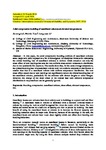Axial compression buckling of castellated columns at elevated temperatures
| dc.contributor.author | Li, Long-yuan | |
| dc.date.accessioned | 2016-06-13T08:21:01Z | |
| dc.date.available | 2016-06-13T08:21:01Z | |
| dc.date.issued | 2016-06-01 | |
| dc.identifier.issn | 0219-4554 | |
| dc.identifier.issn | 1793-6764 | |
| dc.identifier.other | ARTN 1750034 | |
| dc.identifier.uri | http://hdl.handle.net/10026.1/4890 | |
| dc.description.abstract |
<jats:p> In this paper, the axial compression buckling problem of castellated columns about the major axis when exposed to a fire is investigated. An analytical formula for calculating the critical buckling load of castellated columns is derived, which considers not only the shear deformation effect of web openings but also the non-uniform cross-section temperature distribution due to non-symmetric fire exposure. The results show that for the same average temperature, the critical buckling load of a castellated column with non-uniform temperature distribution is smaller than that of a castellated column with uniform temperature distribution. The web shear effect caused due to web openings can significantly reduce the critical buckling load of the castellated column, particularly for the columns with shorter lengths or wider flanges. However, the change of the shear effect on the critical load with different temperature distributions is very small and can be generally ignored. </jats:p> | |
| dc.format.extent | 1750034-1750034 | |
| dc.language | en | |
| dc.language.iso | en | |
| dc.publisher | World Scientific Pub Co Pte Lt | |
| dc.subject | Buckling | |
| dc.subject | compression | |
| dc.subject | castellated column | |
| dc.subject | shear effect | |
| dc.subject | elevated temperature | |
| dc.subject | fire | |
| dc.title | Axial compression buckling of castellated columns at elevated temperatures | |
| dc.type | journal-article | |
| dc.type | Journal Article | |
| plymouth.author-url | https://www.webofscience.com/api/gateway?GWVersion=2&SrcApp=PARTNER_APP&SrcAuth=LinksAMR&KeyUT=WOS:000399075000005&DestLinkType=FullRecord&DestApp=ALL_WOS&UsrCustomerID=11bb513d99f797142bcfeffcc58ea008 | |
| plymouth.issue | 03 | |
| plymouth.volume | 17 | |
| plymouth.publication-status | Published | |
| plymouth.journal | International Journal of Structural Stability and Dynamics | |
| dc.identifier.doi | 10.1142/S0219455417500341 | |
| plymouth.organisational-group | /Plymouth | |
| plymouth.organisational-group | /Plymouth/Faculty of Science and Engineering | |
| plymouth.organisational-group | /Plymouth/Faculty of Science and Engineering/School of Engineering, Computing and Mathematics | |
| plymouth.organisational-group | /Plymouth/REF 2021 Researchers by UoA | |
| plymouth.organisational-group | /Plymouth/REF 2021 Researchers by UoA/UoA12 Engineering | |
| plymouth.organisational-group | /Plymouth/Research Groups | |
| plymouth.organisational-group | /Plymouth/Research Groups/Marine Institute | |
| plymouth.organisational-group | /Plymouth/Users by role | |
| plymouth.organisational-group | /Plymouth/Users by role/Academics | |
| dcterms.dateAccepted | 2016-04-11 | |
| dc.rights.embargodate | 2017-6-1 | |
| dc.identifier.eissn | 1793-6764 | |
| dc.rights.embargoperiod | Not known | |
| rioxxterms.versionofrecord | 10.1142/S0219455417500341 | |
| rioxxterms.licenseref.uri | http://www.rioxx.net/licenses/all-rights-reserved | |
| rioxxterms.licenseref.startdate | 2016-06-01 | |
| rioxxterms.type | Journal Article/Review |


